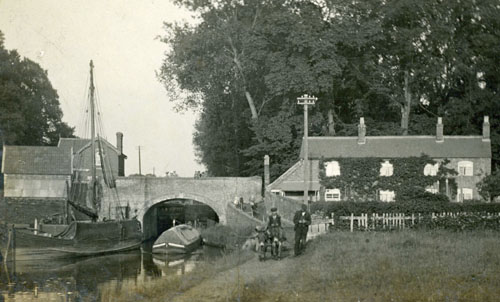Hugh Conway-Jones explores the surprising history of the site of the Western Depot of the Cotswold Canals Trust maintenance team beside Pike Bridge, Eastington. (This article was originally published in the Trow magazine, Winter 2022.)


This old photo of Pike Bridge shows what looks like a row of ordinary cottages on the plot now occupied by the CCT Western Depot, but research in the archives has revealed that the site has an unexpected history.
The first surprise was finding that the original (smaller) building on the plot was actually built by the Stroudwater Company in 1777 while the canal was still under construction. An early occupant was William Beard who was chief carpenter in charge of the general maintenance of the working canal. Unfortunately, the formal transfer of the land to the Company was never completed, and when the estate was sold in 1806, the Company hurriedly had to buy land on the other side of the canal and build a new house there for William Beard. This was later known as Dock House as it was close to the Company's dry dock.
Another surprise was finding that in the 1830s and 1840s, the site of the Western Depot was known as Albert Wharf, occupied by coal merchants John Griffin and his three sons. Griffin also ran a small fleet of barges and boats, each captained by one of his family. These vessels collected coal from South Wales, the Forest of Dean or the Midlands and also road stone from Bristol. Some of these cargoes were delivered to Eastington, but others were part of the general flow of goods along the canals to Brimscombe and beyond. However, when Griffin senior died in 1850, his sons had difficulties continuing the business. After struggling for three years, they had to assign all of their assets to their creditors, primarily the Parkend Coal Company in the Forest of Dean. Nevertheless, the name Albert Wharf remained in use for many years.
By 1881, the house was occupied by a foreman in one of the local woollen cloth mills, and he bought the house in 1904. By that time, the property was known as Bridge House, although the sale transfer still mentioned that the site was suitable for a coal wharf or yard. The house was sold in 1911 and again in 1922, and on both occasions the property was described as a single house - not a row of cottages.
The house did not survive much longer, however, as the County Council wanted it demolished to allow the alignment of the road to be improved at the same time as they were widening Pike Bridge. This work was carried out in 1924, and the residue of the plot became a storage area for road making materials. One interruption to this routine role was the construction of a pill box on the property in 1940. This was part of Stop Line Green, intended to help defend Bristol in the event of an attack from the east. A change in Government policy made the defence line redundant before it was completed, but the pill box is still there.
One more change in use took place in 1991 when the CCT volunteers were tidying up the great work they had done to restore Blunder and Newtown Locks. Their former compound near Blunder Lock needed to be cleared to prepare for landscaping the area, and they negotiated a lease for a new compound on the old County Council tip. It now seems so appropriate that the present centre for managing the maintenance of the canal is on the site of the first head carpenter's house over two hundred years ago.